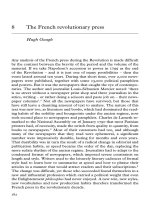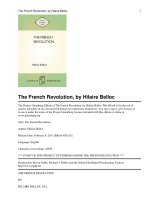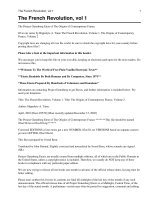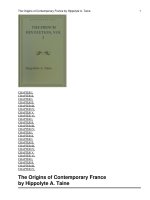The French revolutionary press
Bạn đang xem bản rút gọn của tài liệu. Xem và tải ngay bản đầy đủ của tài liệu tại đây (107.7 KB, 19 trang )
8 The French revolutionary press
Hugh Gough
Any analysis of the French press during the Revolution is made difficult
by the contrast between the brevity of the period and the volume of the
material. If we take Napoleon’s accession to power in as the end
of the Revolution – and it is just one of many possibilities – then the
event lasted around ten years. During that short time, over , news-
papers were published, together with some , political pamphlets
and posters. But it was the newspapers that caught the eye of contempo-
raries. The author and journalist Louis-S´ebastien Mercier noted: ‘there
is no street without a newspaper print shop and three journalists in the
attics, writing – or rather doing a scissors and paste job on – their news-
paper columns’.
Not all the newspapers have survived, but those that
have still leave a daunting amount of text to analyse. The nature of this
text
was new too, as literature and books, which had dominated the
read-
ing habits of the nobility and bourgeoisie under the ancien regime, now
tooksecond place to newspapers and pamphlets. Charles de Lameth re-
marked to the National Assembly on January that most Parisian
printers had, of necessity, made the switch from quality to quantity, from
books to newspapers.
Most of their customers had too, and although
many of the newspapers that they read were ephemeral, a significant
number were impressively durable, lasting for months and even years.
That durability was in turn the result of a radical change in editorial and
publication habits, as speed became the order of the day, replacing the
more sedate rhythm of the ancien regime. Journalists had to adapt to the
condensed format of newspapers, which imposed severe constraints on
length and style. Writers used to the leisurely literary cadences of formal
style had to learn how to summarise at speed and how to phrase their
articles in a manner that would attract readers and their subscriptions.
The change was difficult, yet those who succeeded found themselves in a
new and influential profession which carried a political weight that even
the Enlightenment philosophes had never enjoyed. A new role, new styles,
new vocabularies and new production habits therefore transformed the
French press in the revolutionary decade.
The French revolutionary press
Because of the density of the printed material, all histories of the revolu-
tionary press have had to navigate uneasily between detailed monograph
and impressionistic survey. Two of the most substantial and durable sur-
veys were published in the mid-nineteenth century, by L´eonard Gallois
and Eug`ene Hatin, at a time when journalism was closely linked to the
fortunes of political liberalism.
Gallois’s two-volume history, after a brief
introductory chronological summary, concentrates on the most promi-
nent journalists and the major newspapers. Hatin’s eight-volume history,
published fifteen years later, begins well before the Revolution but de-
votes most of its attention to the period to , concentrating like
Gallois on both personalities and titles. Both are concerned mainly with
the emergence of the Parisian press and pay little attention to develop-
ments outside the capital. Several other general histories were published
in the late nineteenth and early twentieth centuries, but the first significant
advance on the groundworkdone by Gallois and Hatin appeared only in
the late s, with the publication of a five-volume history of the French
press in which the revolutionary period was covered by Jacques Godechot.
A well-respected political historian of the Revolution, Godechot substan-
tially updated Hatin’s approach, linking the fortunes of the press to the
politics of the Revolution and incorporating research carried out during
the intervening years, some of it by his own research students.
Since
, other books and articles have both extended our knowledge of the
press and transformed our understanding of its role.
Little of this research has made any overt attempt to linkin with
Habermas’s views on the relationship between social change and the
emergence of public space. Habermas’s path-breaking book first ap-
peared in French translation in , sixteen years after its initial publi-
cation and eleven years before its appearance in English.
For much of
the forty years that have elapsed since its initial publication, the tradi-
tional historian’s suspicion of sociology combined with scepticism over
Habermas’s Marxist approach has ensured that his workwas largely
ignored, except by historians of ancien regime public opinion.
Among
the latter, two historians of the press, JackCenser and Jeremy Popkin, be-
cause of their interests in the links between ancien regime and Revolution,
have related parts of their research to Habermas’s ideas on the growth of
an autonomous ‘public sphere’.
In a recent study of the ancien regime
press, Censer has stressed the important role played by articles in the ad-
vertising journals, or Affiches, in articulating the themes of a Habermas-
style bourgeois civil society. However, he also notes their relative failure
in airing political issues and controversy.
Nevertheless the political press that appeared in France in did not
emerge overnight. Despite the persistence until of pre-publication
Hugh Gough
censorship and licensing control, the press had expanded during the eigh-
teenth century and over forty provincial, and almost as many Parisian,
journals were being published at the beginning of . In addition, sev-
eral foreign newspapers such as the Gazette de Leyde and the Courrier
d’Avignon were allowed to circulate relatively freely.
However, except in
periods of instability or factional division at court, the political content
of the domestic press was carefully controlled, and articles on French
politics were scarce and conformist. Readers interested in subversive
commentary on court politics were better catered for in the underground
pamphlet press, which was better equipped to evade censorship and paint
a lurid picture of a court allegedly embroiled in sexual and financial
scandal.
Nevertheless, as Jeremy Popkin has argued, some develop-
ments anticipated the transformation of . Certain editors developed
the technique of analytical narrative that their revolutionary counterparts
were later to perfect, blending chronological detail with ideological com-
mentary. In addition, Simon-Nicolas-Henr
i Linguet
’s mixture of per-
sonalised polemic and conspiracy theory, in his Annales politiques, civiles
et litt´eraires, anticipated the sensationalist style that Marat, H´ebert and
others were to exploit with devastating success. Above all, several of the
foreign journals developed techniques of political narrative which built
up anticipation and uncertainty in the mind of the reader in a way that
revolutionary journalists were later to do.
These developments were straws in the wind, but until radically
changed the context of press activity, that wind was really only a breeze.
Then, in May , during the early days of the meetings of the Estates
General, Mirabeau defied government censorship by producing a news-
paper under the guise of a published form of correspondence with his
constituents in Provence. Several other newspapers followed suit, provid-
ing accounts of the crucial Assembly debates of May and June, before the
fall of the Bastille threw the floodgates open in July. By the end of the year,
new journals had appeared in Paris and thirty-five in the provinces.
During and , more than new journals appeared each year,
and this number dipped only slightly in . Even during the Terror, at a
time when censorship and the guillotine were powerful disincentives, new
journals appeared at
a rate of almost ten per month.
The rate climbed
again after Thermidor, with the collapse of the Terror, and only during
the latter years of the Directory, when censorship became draconian,
did it decline again.
Many of these newspapers were extremely short-
lived, yet others like the R´evolutions de Paris, the Patriote fran¸cois or the
Ami du roi stayed in production for several years and wielded significant
political influence. Some even survived into the nineteenth century. The
Gazette universelle, for example, was launched in the autumn of and
The French revolutionary press
defended constitutional royalism through no less than three major title
changes until its closure in . The Moniteur, launched in the dying
weeks of , was even more durable, lasting in various guises until the
German invasion of .
This kind of growth was made possible by the collapse of censorship
in the summer of . The principle of press freedom was written into
article of the Declaration of the Rights of Man in August , with the
explicit understanding that subsequent legislation would define its legal
limits: ‘The free communication of thoughts and opinions is one of the
most precious rights of man; ev
ery citizen can therefore speak, write and
print freely, except to answer for abuse of this freedom in cases laid down
by the law.’ Yet drafting a definition of ‘abuse’ and establishing a legal
mechanism for its control was not easy in a time of such rapid political
change, and debates in the National Assembly over the next two years
revealed deep divisions between deputies over the relative advantages of
freedom and control. Few were prepared to defend the ancien regime
practice of prior censorship, but many of the centre and right wanted
to ensure that editors guilty of publishing libellous or seditious articles
would be prosecuted. Defining libel and sedition, however, was the stum-
bling blockas there was no consensus on the issue. However much the ma-
jority of deputies was appalled by the excesses of Marat’s Ami du peuple or
Camille Desmoulins’s R´evolutions de France et de Brabant, they were wary
of passing legislation that might be exploited to suppress all radical crit-
icism. Indeed, a minority on the left, led by Robespierre and P´etion,
opposed any specific press legislation at all and argued that the laws of
libel were sufficient protection. As a result, it was only in late August
that two constitutional articles were finally passed, defining a number of
press ‘offences’ (including the incitement to commit an illegal act and the
discrediting of public officials) and providing for trials to be held before a
jury.
Yet they were to prove ineffective and vanished with the constitution
a year later
.
In the debate between and the right argued consistently that
social order and stable government required press restraint, while the left
replied that a free press was essential for the development of an enlight-
ened public opinion. Those arguments changed sides, however, in the
summer of , as war led to Republic and Terror. Several right-wing
journals were closed down in the aftermath of Louis XVI’s removal on
August, and although many reappeared with new titles and a conser-
vative republican editorial policy, the Convention declared support for
monarchy a capital offence before the end of the year. Legislation in the
spring of added support for counter-revolution to the list of capital
offences and the law of suspects of September widened the net
Hugh Gough
still further. The Jacobin left that had opposed censorship in now
defended it as a political necessity. Leading Girondin newspapers were
closed down, their editors and printers imprisoned and guillotined, and
dissident Jacobin journalists suffered the same fate. Among them were
prominent political personalities such as Camille Desmoulins, editor of
the VieuxCordelier, and Jacques-Ren´eH´ebert, whose P`ere Duchˆene had an
enthusiastic following among the Parisian sans-culottes and the Cordeliers
club. The Jacobin attitude to the press was perhaps best expressed by
a secretary of the Committee of General Security, Momory, sent to
supervise the arrest of a jour
nalist, Jean-Charles Laveaux, in Paris in the
spring of . When Laveaux protested at the impounding of his press
along with his papers, Momory merely replied: ‘a printing press is a piece
of property with which one can do a great deal of harm’.
After Robespierre’s fall in the summer of Jacobin policies were re-
versed and press freedom became a Thermidorean symbol for resistance
to the Terror. A lively press sprang up which was virulently anti-Jacobin,
outspokenly conservative and frequently royalist. This prompted legisla-
tion against the right-wing press in the spring of , and further leg-
islation in the spring of , directed against both the extreme left and
the extreme right. Yet both were ineffective, as juries simply refused to
convict because they considered the penalties too harsh. Effective action
only came with the Fructidor coup d’´etat of September , when over
seventy newspapers were closed and the Directors empowered to ban
any newspaper considered a threat to political stability. A stamp tax was
introduced weeks later, which raised production costs significantly and
sent many of the smaller papers to the wall. These draconian powers were
renewed in the following year and used against both royalist and Jacobin
journals, until the Brumaire coup of brought Napoleon to power.
He rapidly refined the Directory’s arsenal of repression and, by its final
years, the First Empire had created a censorship regime that made that
of the ancien regime seem mild in comparison.
Press freedom, therefore, thrived between and , then again
between and . The periods of the Terror and the Second
Directory (–) were more restrictive. Yet law was not the only
means open to governments for press control. Money was too, and almost
every revolutionary regime attempted to buy favourable press coverage.
Louis XVI subsidised royalist titles, and the Girondin ministry which
succeeded the monarchy in August set up a propaganda bureau
under the control of Jean-Marie Roland at the Ministry of the Interior,
which subsidised a range of pro-Girondin journalists and pamphleteers
to encourage Roland’s brand of moderate republicanism. Although
Jacobin protests forced the bureau’s closure in January , the Jacobins
The French revolutionary press
themselves used the same methods. Once in power, they used government
subsidies to bolster up a range of radical newspapers, including the Feuille
de salut public, which the Committee of Public Safety established as its
own mouthpiece in the autumn of . Jacobin clubs in Paris and the
provinces also subsidised their own newspapers.
The practice of gov-
ernment subsidies continued after Thermidor and, although galloping
inflation and state penury reduced the Directory’s resources, it provided
intermittent press subsidies between and , and financed its own
newspaper, the R´edacteur, from the winter of – onwards.
Although censorship and patronage affected the conditions under
which journalists worked, the business structures of journalism remained
relatively unchanged during the Revolution. Methods remained artisanal,
with small workshops using hand-operated wooden presses that had
changed very little for over three centuries. Large enterprises existed,
but they were rare. During the last years of the ancien regime, Charles-
Joseph Panckoucke had emerged as a press baron in Paris, controlling
major titles such as Gazette de France, the Mercure and the Journal de
Bruxelles. Aware that the collapse of privilege threatened his dominance,
Panckoucke launched the Moniteur in the late autumn of .Committed
to extensive news coverage and to detailed reports of Assembly debates,
the Moniteur rapidly established itself as an authoritative daily journal of
record. At the height of its success, along with Panckoucke’s other news-
papers, it kept twenty-seven presses busy and employed ninety-one work-
ers. Others shared Panckoucke’s approach. Louis-Marie Prudhomme
was a minor bookseller before the Revolution, but in July of he
reprinted someone else’s pamphlet on the fall of the Bastille, which was
an immediate commercial success. He promptly relaunched it as a weekly
newspaper, the R´evolutions de Paris, which was to last until the early spring
of and generated enough profits to enable him to buy his own presses
and print shop. At the height
of his success, Prudhomme owned fourteen
presses and employed a team of jour
nalists, a press manager, a sales man-
ager, numerous print workers and several hundred part-time assistants.
Elsewhere in Paris the Gazette universelle occupied eight presses in ,
with daily sales of , copies and the Journal du soir used five presses
for its , daily copies, employing sixty print workers and up to
street vendors.
Yet these large-scale enterprises were atypical and most revolution-
ary newspapers were small-scale operations with a rudimentary business
structure. An editor wrote his text and contracted with a printer to print
and distribute it. He then either paid the printer out of his subscription
revenue, and pocketed the rest as profit, or entered into a shared arrange-
ment for the distribution of costs and profits. The well-documented case
Hugh Gough
of Ferr´eol de Beaugeard, owner and editor of the Journal de Marseille for
fourteen years between and , is just one of dozens of this kind
of operation.
Alternatively, printers who wanted to maximise the use of
their presses did as many had already done for the ancien regime Affiches,
by employing a writer or political activist to write the text of a newspaper
in return for a salary. The highly successful Courrier de Strasbourg, pub-
lished between and , was owned by the bookseller and printer
Jean-Georges Treuttel. He employed a writer and Jacobin activist, Jean-
Charles Laveaux, as his editor, paying him an annual salary and retaining
the profits for himself. There were variants on both these models and, as
the Revolution progressed, the money involved in a successful newspaper
led to increasingly complex contracts. Yet the basic structures remained
the same, because social and economic conditions made them viable. On
the editorial side there was no lackof potential journalists with political
ambition looking for work, while on the production side the collapse of
controls on the printing trade and the minimal costs involved in setting
up a press led to a massive growth in printers.
The wooden hand-press
may have struggled to produce printed sheets an hour, but it had
the advantage of being cheap to build, buy and run. Editors rarely had
a problem finding a printer, except in the more sleepy provincial towns,
and many bought their own press and ran the entire operation them-
selves. That was how Marat began his Ami du peuple in the autumn of
, before he opted to use printers who paid him a cash sum for his
text.
Who were the journalists who provided much of the dynamism behind
press growth? No one has attempted detailed prosopographical analysis
for the Revolution to match the dictionary of ancien regime journalists
produced by Jean Sgard, although William J. Murray has carried out a
partial analysis for the early years.
This shows that journalists could
be either young – in their twenties – or relatively old – in their forties or
fifties. They also came from a wide social spectrum of literate society,
from the sons of artisans at the lower end of the scale to the nobility at
the top. A significant number were former nobles, such as Condorcet or
Mirabeau, while priests were prominent too, with non-jurors such as the
abb´e Royou and constitutional priests such as Claude Fauchet or Euloge
Schneider. Lawyers were ubiquitous, but a range of other occupations is
represented too, including doctors (Marat), minor philosophes (Carra and
Gorsas), actors (Aristide Valcour) and printers too numerous to mention.
Like Andr´e Malraux’s Gaullists, the Revolution’s journalists came from
the eighteenth-century equivalent of the Paris Metro.
Yet wherever they came from, journalists entered an occupation which
was increasingly being considered a distinct profession with its own rules









